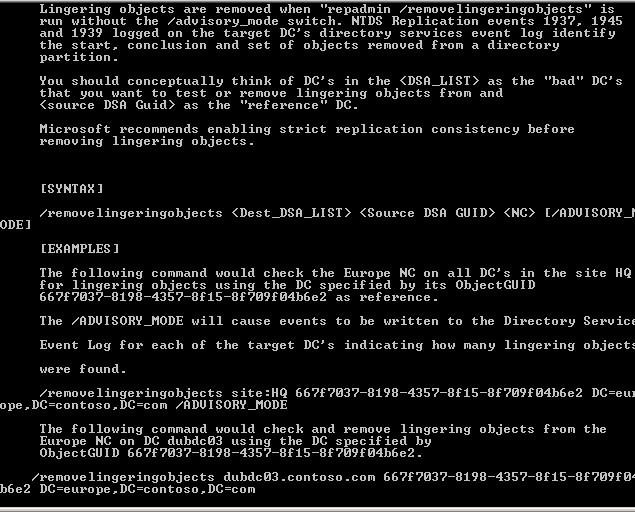Browse All Articles > Lingering Objects Troubleshooting
Hi,
It seems that most of people face problems with lingering objects in domain and because of incorrect troubleshooting involving AD replication, tombstone lifetime problem increases.
I request everybody to read the following information to avoid such issues:
Problem: Event id 2042
You have AD replication issues. Example: 10 DCs and one of them fails to replicate. The box has crossed the TSL (Tombstone Lifetime) time period.
Behaviour
By design, Server do not replicate beyond Tombstone time period as it can introduce lingering objects.
Checks:
Do we have Strict Replication Consistency enabled?:
HKEY_LOCAL_MACHINE\System\CurrentControlSet\Services\NTDS\Parameters
Value Name: Strict Replication Consistency
Data type: REG_DWORD
Value data: 1
Note: By default, W2k3 domain upgraded from W2k will have loose replication.
Enable strict replication consistency on All DCs
More info on: http://technet2.microsoft.com/WindowsServer/en/library/ea3330c4-1d58-457e-9ad6-97f1573999ff1033.mspx?mfr=true
Find what caused the replication problem? Was it DNS?? If yes, you may want to fix it first..
W2k3 domain with W2k3 DCs:
You have two options:
Set the Strict Repl Cons to 1 on all the boxes and put in the following value and set it to 1:
HKLM\System\CurrentControlSet\Services\NTDS\Parameters
REG_DWORD Value: Allow Replication With Divergent and Corrupt Partner
At this point you could use repadmin /removelingeringobejcts to remove the lingering objects on problem server which should solve your problem.
2 nd option: Demote the server, try to avoid this as above tool fixes the problem.
Incase of W2k domain with W2k DCs:
Enable strict consistency first and then fix the DNS etc At this point if there are no lingering objects, replication should proceed. If there are lingering objects then we will get error messages pointing out the lingering object. Here, we can decide on any of our available lingering object removal options for W2K replfix or Kb314282.![Lingering object commands]()
It seems that most of people face problems with lingering objects in domain and because of incorrect troubleshooting involving AD replication, tombstone lifetime problem increases.
I request everybody to read the following information to avoid such issues:
Problem: Event id 2042
You have AD replication issues. Example: 10 DCs and one of them fails to replicate. The box has crossed the TSL (Tombstone Lifetime) time period.
Behaviour
By design, Server do not replicate beyond Tombstone time period as it can introduce lingering objects.
Checks:
Do we have Strict Replication Consistency enabled?:
HKEY_LOCAL_MACHINE\System\
Value Name: Strict Replication Consistency
Data type: REG_DWORD
Value data: 1
Note: By default, W2k3 domain upgraded from W2k will have loose replication.
Enable strict replication consistency on All DCs
More info on: http://technet2.microsoft.
Find what caused the replication problem? Was it DNS?? If yes, you may want to fix it first..
W2k3 domain with W2k3 DCs:
You have two options:
Set the Strict Repl Cons to 1 on all the boxes and put in the following value and set it to 1:
HKLM\System\CurrentControl
REG_DWORD Value: Allow Replication With Divergent and Corrupt Partner
At this point you could use repadmin /removelingeringobejcts to remove the lingering objects on problem server which should solve your problem.
2 nd option: Demote the server, try to avoid this as above tool fixes the problem.
Incase of W2k domain with W2k DCs:
Enable strict consistency first and then fix the DNS etc At this point if there are no lingering objects, replication should proceed. If there are lingering objects then we will get error messages pointing out the lingering object. Here, we can decide on any of our available lingering object removal options for W2K replfix or Kb314282.

Have a question about something in this article? You can receive help directly from the article author. Sign up for a free trial to get started.

Comments (2)
Commented:
Commented: